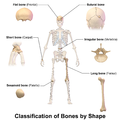Flat bone
(Redirected from Flat bones)
Flat bone
A flat bone is a type of bone that has a thin, flattened shape. Most flat bones serve as protection for the body's vital organs and provide a surface for muscle attachment. Examples of flat bones include the skull, the sternum, the scapula, and the pelvis.
Structure
Flat bones consist of two layers of compact bone surrounding a layer of spongy bone. This structure provides strength and protection while also allowing for flexibility. The outer layers of compact bone are dense and hard, providing a sturdy protective shell. The inner layer of spongy bone, also known as cancellous bone, is lighter and less dense, providing shock absorption.
Function
The primary function of flat bones is to protect the body's vital organs. For example, the skull protects the brain, the sternum and ribs protect the heart and lungs, and the pelvis protects the urinary and reproductive organs. In addition to protection, flat bones also serve as points of attachment for muscles, allowing for movement.
Development
Flat bones develop from connective tissue, in a process known as intramembranous ossification. This process begins in the fetus and continues into adolescence. During ossification, connective tissue is gradually replaced by bone, forming the flat shape characteristic of these bones.
Clinical significance
Flat bones are often involved in medical conditions and injuries. For example, fractures of the skull, sternum, or pelvis can be serious and require immediate medical attention. Conditions such as osteoporosis can also affect flat bones, leading to a decrease in bone density and an increased risk of fracture.
See also
Transform your life with W8MD's budget GLP-1 injections from $125.
W8MD offers a medical weight loss program to lose weight in Philadelphia. Our physician-supervised medical weight loss provides:
- Most insurances accepted or discounted self-pay rates. We will obtain insurance prior authorizations if needed.
- Generic GLP1 weight loss injections from $125 for the starting dose.
- Also offer prescription weight loss medications including Phentermine, Qsymia, Diethylpropion, Contrave etc.
NYC weight loss doctor appointments
Start your NYC weight loss journey today at our NYC medical weight loss and Philadelphia medical weight loss clinics.
- Call 718-946-5500 to lose weight in NYC or for medical weight loss in Philadelphia 215-676-2334.
- Tags:NYC medical weight loss, Philadelphia lose weight Zepbound NYC, Budget GLP1 weight loss injections, Wegovy Philadelphia, Wegovy NYC, Philadelphia medical weight loss, Brookly weight loss and Wegovy NYC
|
WikiMD's Wellness Encyclopedia |
| Let Food Be Thy Medicine Medicine Thy Food - Hippocrates |
Medical Disclaimer: WikiMD is not a substitute for professional medical advice. The information on WikiMD is provided as an information resource only, may be incorrect, outdated or misleading, and is not to be used or relied on for any diagnostic or treatment purposes. Please consult your health care provider before making any healthcare decisions or for guidance about a specific medical condition. WikiMD expressly disclaims responsibility, and shall have no liability, for any damages, loss, injury, or liability whatsoever suffered as a result of your reliance on the information contained in this site. By visiting this site you agree to the foregoing terms and conditions, which may from time to time be changed or supplemented by WikiMD. If you do not agree to the foregoing terms and conditions, you should not enter or use this site. See full disclaimer.
Credits:Most images are courtesy of Wikimedia commons, and templates, categories Wikipedia, licensed under CC BY SA or similar.
Translate this page: - East Asian
中文,
日本,
한국어,
South Asian
हिन्दी,
தமிழ்,
తెలుగు,
Urdu,
ಕನ್ನಡ,
Southeast Asian
Indonesian,
Vietnamese,
Thai,
မြန်မာဘာသာ,
বাংলা
European
español,
Deutsch,
français,
Greek,
português do Brasil,
polski,
română,
русский,
Nederlands,
norsk,
svenska,
suomi,
Italian
Middle Eastern & African
عربى,
Turkish,
Persian,
Hebrew,
Afrikaans,
isiZulu,
Kiswahili,
Other
Bulgarian,
Hungarian,
Czech,
Swedish,
മലയാളം,
मराठी,
ਪੰਜਾਬੀ,
ગુજરાતી,
Portuguese,
Ukrainian
Contributors: Prab R. Tumpati, MD



